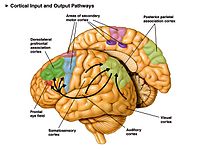
Photo from wikipedia
Tourette syndrome (TS) is a hyperkinetic movement disorder characterised by the occurrence of chronic motor and vocal tics, and is associated with alterations in the balance of excitatory and inhibitory… Click to show full abstract
Tourette syndrome (TS) is a hyperkinetic movement disorder characterised by the occurrence of chronic motor and vocal tics, and is associated with alterations in the balance of excitatory and inhibitory signalling within key brain networks; in particular the cortical-striatal-thalamic-cortical (CSTC) brain circuits that are implicated in movement selection and habit learning. Converging evidence indicates abnormal brain network function in TS may be largely due to the impaired operation of GABA signalling within the striatum and within cortical motor areas, leading to the occurrence of tics. TS has been linked to a heightened sensitivity to somatic stimulation and altered processing of somatosensory information, and there is evidence to indicate that alterations in GABAergic function is likely to contribute to altered somatomotor function. Based upon this evidence, we hypothesised that the specificity of somatomotor representations in primary motor cortex would likely be reduced in individuals with TS. To test this, we used a rapid acquisition method together with neuronavigated transcranial magnetic stimulation (nTMS) to measure the cortical representation of a several different muscles in a group of young adults with TS and a matched group of typically developing individuals.
Journal Title: Cortex
Year Published: 2020
Link to full text (if available)
Share on Social Media: Sign Up to like & get
recommendations!